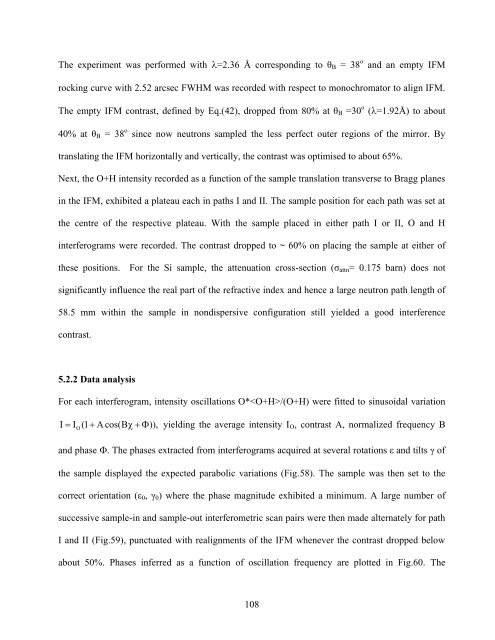PHYS01200804001 Sohrab Abbas - Homi Bhabha National Institute
PHYS01200804001 Sohrab Abbas - Homi Bhabha National Institute
PHYS01200804001 Sohrab Abbas - Homi Bhabha National Institute
You also want an ePaper? Increase the reach of your titles
YUMPU automatically turns print PDFs into web optimized ePapers that Google loves.
The experiment was performed with =2.36 Å corresponding to θ B = 38 o and an empty IFM<br />
rocking curve with 2.52 arcsec FWHM was recorded with respect to monochromator to align IFM.<br />
The empty IFM contrast, defined by Eq.(42), dropped from 80% at θ B =30 o (=1.92Å) to about<br />
40% at θ B = 38 o since now neutrons sampled the less perfect outer regions of the mirror. By<br />
translating the IFM horizontally and vertically, the contrast was optimised to about 65%.<br />
Next, the O+H intensity recorded as a function of the sample translation transverse to Bragg planes<br />
in the IFM, exhibited a plateau each in paths I and II. The sample position for each path was set at<br />
the centre of the respective plateau. With the sample placed in either path I or II, O and H<br />
interferograms were recorded. The contrast dropped to ~ 60% on placing the sample at either of<br />
these positions. For the Si sample, the attenuation cross-section (σ attn = 0.175 barn) does not<br />
significantly influence the real part of the refractive index and hence a large neutron path length of<br />
58.5 mm within the sample in nondispersive configuration still yielded a good interference<br />
contrast.<br />
5.2.2 Data analysis<br />
For each interferogram, intensity oscillations O*/(O+H) were fitted to sinusoidal variation<br />
I I<br />
O(1 A cos(B )), yielding the average intensity I O , contrast A, normalized frequency B<br />
and phase . The phases extracted from interferograms acquired at several rotations ε and tilts γ of<br />
the sample displayed the expected parabolic variations (Fig.58). The sample was then set to the<br />
correct orientation (ε 0 , γ 0 ) where the phase magnitude exhibited a minimum. A large number of<br />
successive sample-in and sample-out interferometric scan pairs were then made alternately for path<br />
I and II (Fig.59), punctuated with realignments of the IFM whenever the contrast dropped below<br />
about 50%. Phases inferred as a function of oscillation frequency are plotted in Fig.60. The<br />
108
















